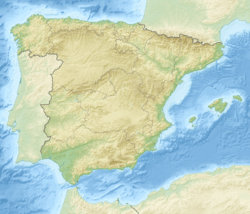Galve, Teruel facts for kids
Quick facts for kids
Galve, Spain
|
|
|---|---|
| Country | Spain |
| Autonomous community | Aragon |
| Province | Teruel |
| Municipality | Galve |
| Area | |
| • Total | 61.90 km2 (23.90 sq mi) |
| Population
(2018)
|
|
| • Total | 161 |
| Time zone | UTC+1 (CET) |
| • Summer (DST) | UTC+2 (CEST) |
Galve is a small town located in the province of Teruel, in the Aragon region of Spain. In 2018, about 161 people lived there. Galve is very famous for its amazing fossil sites, especially for dinosaur fossils!
Contents
Discovering Ancient Life in Galve
Galve is a super important place for finding fossils. It's like a treasure chest full of clues about ancient animals. Many different kinds of fossils have been found here. These include dinosaurs, mammals, lizards, and turtles.
Spanish paleontologists, who are scientists who study fossils, have worked in Galve for many years. Some of these scientists include José Ignacio Canudo, José Luis Barco, Gloria Cuenca-Bescós, and José Ignacio Ruiz-Omeñaca.
The rocks in the Galve region are very old. They date back to the Late Jurassic and Early Cretaceous periods. These periods were between about 163 million and 100 million years ago. Scientists study different rock layers, called formations, to understand the past.
Ancient Animals of Galve
Many different types of animals have been found as fossils in Galve. These discoveries help us learn about life on Earth millions of years ago.
Dinosaurs of Galve
Many kinds of dinosaurs have been found in the Galve region. These include meat-eating dinosaurs called theropods, huge long-necked dinosaurs called sauropods, and plant-eating dinosaurs called ornithischians.
Scientists have found fossil teeth from different types of theropods. These include baryonychines (a type of spinosaurine), allosauroids, and dromaeosaurids. Some teeth found here are from coelurosaurs, which are a group of theropods that includes birds.
Sauropods in Galve
Sauropods were giant, plant-eating dinosaurs with long necks and tails. Several important sauropods have been found in Galve:
- Aragosaurus ischiaticus
- Galveosaurus herreroi
- Turiasaurus riodevensis
Scientists are still studying these dinosaurs to understand exactly where they fit in the dinosaur family tree. For example, Aragosaurus has been linked to different groups over time. Galveosaurus was first thought to be one type of sauropod, but new studies suggest it might be a turiasaur. Turiasaurus is a very large sauropod that belongs to a special group of dinosaurs called Turiasauria.
There was a small mix-up when Galveosaurus was first named. In 2005, one group of scientists named it Galveosaurus herreroi. Later that same year, another team published an article and called it Galvesaurus herreroi (with an 's' instead of an 'o'). Both names were for the same dinosaur!
Teeth similar to those of Camarasaurus, another type of sauropod, have also been found. However, these teeth are from a much younger time period than actual Camarasaurus fossils. This means they likely belong to a different, but similar, dinosaur.
Heterodontosaurids in Galve
Heterodontosaurids are a group of small, plant-eating dinosaurs. They are mostly known from the Early Jurassic period and are often found in southern Africa. Finding them in Galve is special because it shows they lived in other places too.
Ancient Crocodilians
Many crocodilians, which are relatives of modern crocodiles, have been found in Galve. One amazing discovery is a set of fossil footprints from a giant crocodyliform. This ancient crocodile was about 12 meters (almost 40 feet) long! That's as big as some of the largest crocodiles ever known, like Deinosuchus and Sarcosuchus.
Scientists have also found teeth, bony plates (called osteoderms), and bones from other types of ancient crocodiles. These include atoposaurids and Bernissartia. This shows that many different kinds of crocodiles lived in the Galve area long ago.
Pterosaurs in Galve
Pterosaurs were flying reptiles, not dinosaurs, but they lived at the same time. While complete pterosaur fossils are rare in Galve, scientists have found many of their teeth. These teeth tell us that a wide variety of pterosaurs once soared over the Galve region. Some of the types found include ornithocheirids, dsungaripterids, and istiodactylids.
See also
 In Spanish: Galve para niños
In Spanish: Galve para niños


